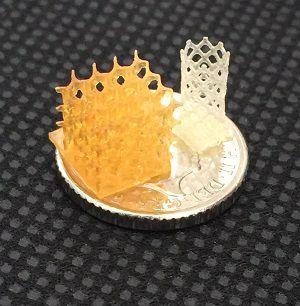Surgically implanted 3D printed tissue scaffolds that harmlessly degrade in the body could aid tissue regeneration. Over recent years 3D printing has become vitally important in the medical field, with particular utility in tissue engineering. Yet, the application of 3D printed tissue scaffolds still has limitations that must be overcome. In particular, researchers are searching for a way of making such scaffolds minimally invasive and compatible with patients’ tissues whilst still providing mechanical support as the healing process goes to work on damaged tissues.

4D Biomaterial's resins can print bioresorbable tissue scaffolds. Image Credit The University of Birmingham
A team of researchers led by Professor Andrew Dove from the University of Birmingham’s chemistry faculty may have come up with a solution. The scientists have developed a 3D printed tissue scaffold that can be transplanted into patients promoting tissue regeneration before harmlessly degrading. The team says that the scaffold that can support cell migration and blood vessel growth works through a property labeled ‘shape memory.’
“The scaffolds have evenly distributed and interconnected pores that allow diffusion of nutrients from surrounding tissues,” says Dove. “The shape-memory means this structure is retained when the scaffold is implanted into tissues, and this supports the infiltration of cells into the scaffold while encouraging tissue regeneration and revascularization.”
The team created the tissue scaffolds with the use of resin inks that were pioneered during a major program of biomaterials research at the University of Birmingham that Dove also spearheaded. The resin is commercially available under the name 4Degra from 4D Biomaterials.
Dove is one of the authors of a study detailing the development of the 3D printed tissue scaffold published in the journal Nature Communications¹.
3D Printed Scaffold Towers Over Current Alternatives
The 3D printed scaffold developed by the University of Birmingham team has several advantages over current approaches to tissue support when it comes to filling tissue voids, thanks to its impressive flexibility.
The elasticity provided by 4Degra means that the scaffold can conform to irregular spaces created by trauma or surgery, which could be individual to every patient and difficult to predict. The team demonstrated this ability by testing the scaffold in irregular voids created in an alginate gel, which acted as a stand-in for body tissues and with rodent testing.
The researchers found that the 3D printed scaffold can also withstand compression of up to 85% while still retaining the ability to return to its original shape with the material’s pore size unaffected, meaning that its functionality is unimpaired.
But the ability to individualize that scaffold does not end with its shape. By tailoring the composition of the 4Degra resin used to create the structures, the team found they could create tissue scaffolds with a range of strengths meaning that it could be transmitted into a variety of tissues with different densities and still be compatible and encourage regeneration.
But, the researchers are not just concerned with how their 3D material functions in the 3 dimensional void of damaged tissue. They also wanted to know how it performed in the fourth dimension.
3D printed materials have received a lot of attention in the tissue engineering world. However, void-filling materials to provide mechanical support, biocompatibility, and surface erosion characteristics that ensure consistent tissue support during the healing process, and this means a fourth dimension — time — needs to be considered in material design.
Professor Andrew Dove, Chemistry Faculty, The University of Birmingham
Simulating insertion in fat tissue, the University of Birmingham team found tissue regenerative performance in line with normal tissue restoration rather than regeneration triggered by damaged and scarred tissue or an inflammatory response. Healthy blood vessels were observed growing around the structure just two months after it was implanted.
The scaffold remained compatible with the host’s tissues months after insertion. The team estimates that the 3D printed intervention could continue to function, providing support and encouraging healing in damaged tissues for up to a year.
As the 4Degra resin biodegrades via surface erosion, it does so without leaving behind acidic products, remaining non-toxic to living cells.
What is Next for 3D Printed Tissue Scaffolds?
Dove says that the technology developed and tested by his team demonstrated that it is possible to develop highly porous scaffolds with shape memory. The next step for the material is its application in self-fitting scaffolds that can adapt to voids in soft tissues after being applied in minimally invasive procedures without damaging surrounding tissues.
For the manufacturers of 4Degra work continues on the scaling up of the production of the resin ink. The company, which was founded in May 2020 as an offshoot of the University of Birmingham’s enterprise program, is already offering the material to 3D printing concerns and the manufacturers of medical devices from its lab in MediCity, Nottingham.
We are looking to collaborate with innovative companies in Europe and North America to develop a new generation of 3D-printed medical devices that translate the unique advantages of the 4Degra resin-ink platform into improved treatment outcomes for patients.
Phil Smith, CEO, 4D Biomaterials
Disclaimer: The views expressed here are those of the author expressed in their private capacity and do not necessarily represent the views of AZoM.com Limited T/A AZoNetwork the owner and operator of this website. This disclaimer forms part of the Terms and conditions of use of this website.
Source:
Weems. A. C., Arno. M. C., Yu. W., Huckstepp. R. T. R., Dove. A. P., [2021], ‘4D polycarbonates via stereolithography as scaffolds for soft tissue repair,’ Nature Communications, [https://doi.org/10.1038/s41467-021-23956-6].